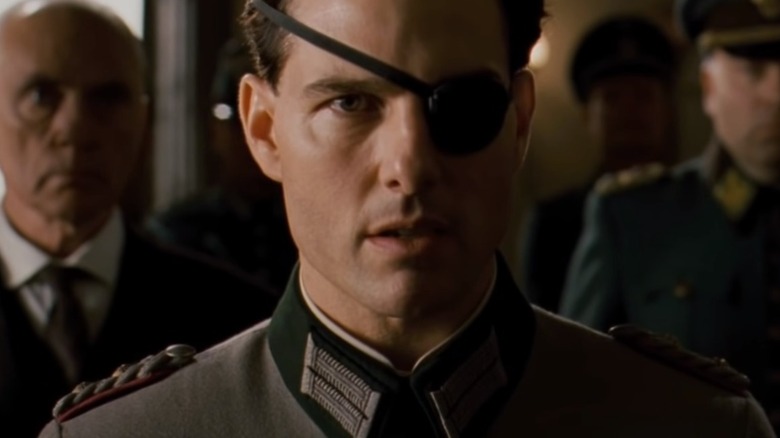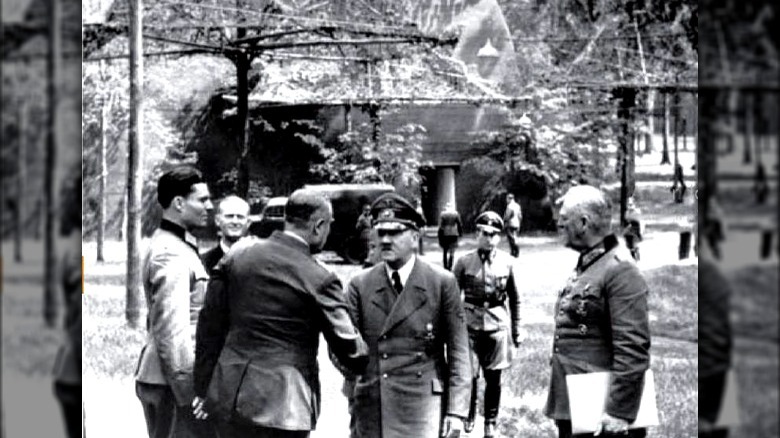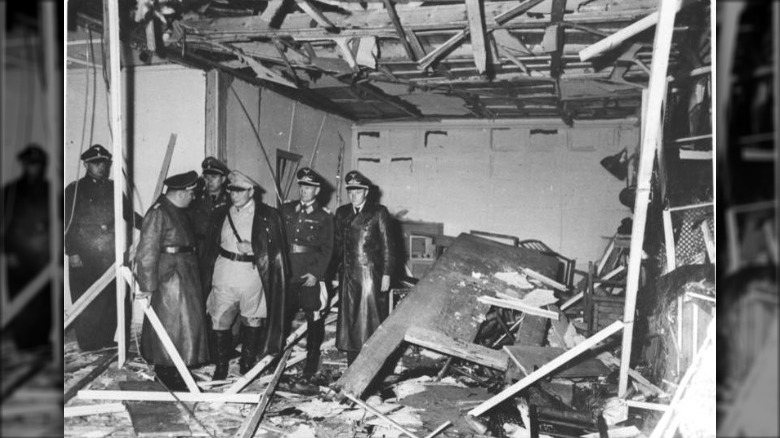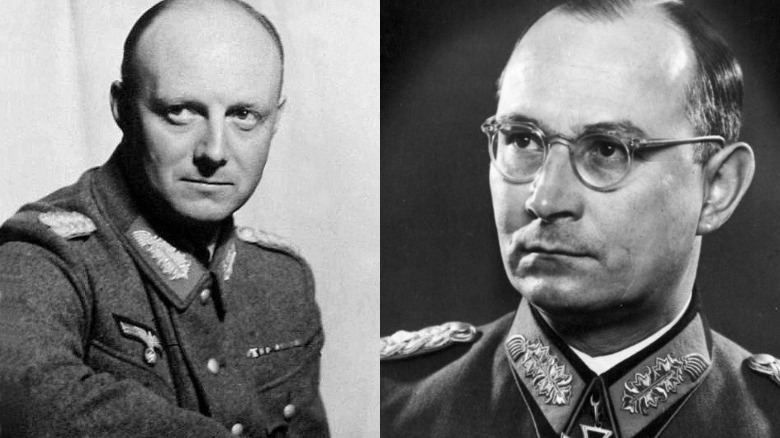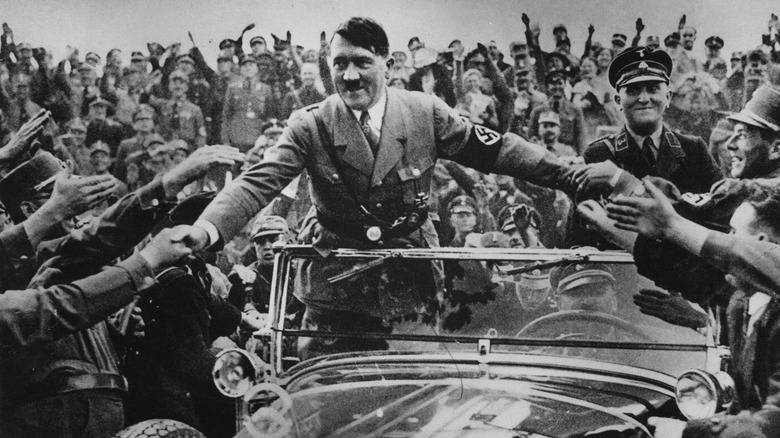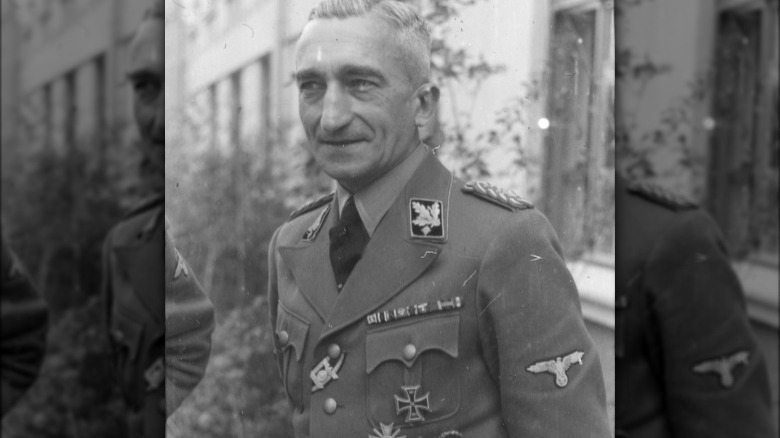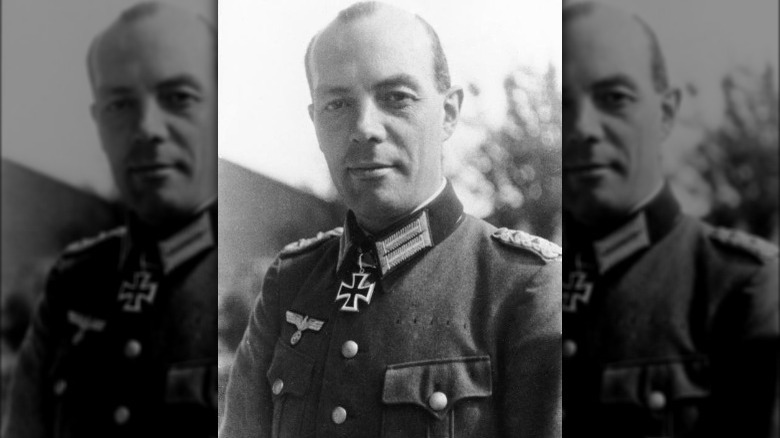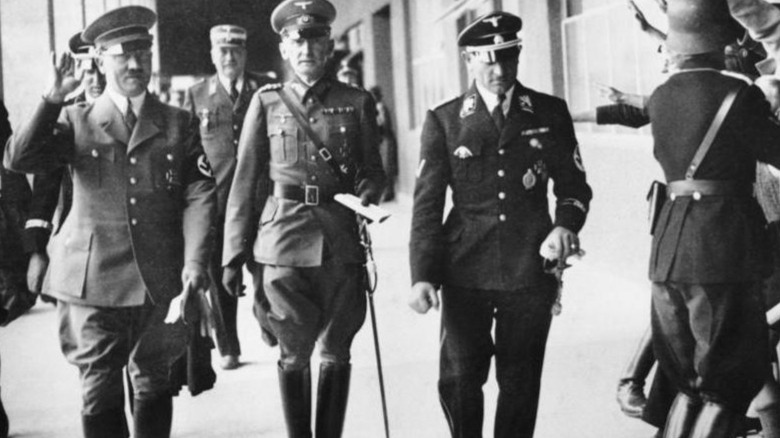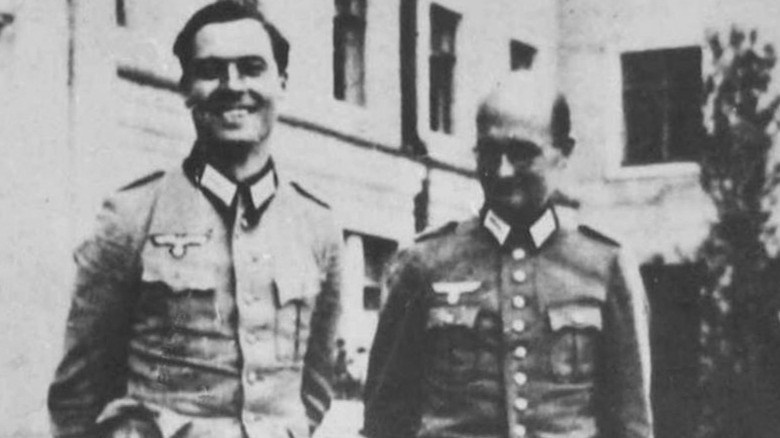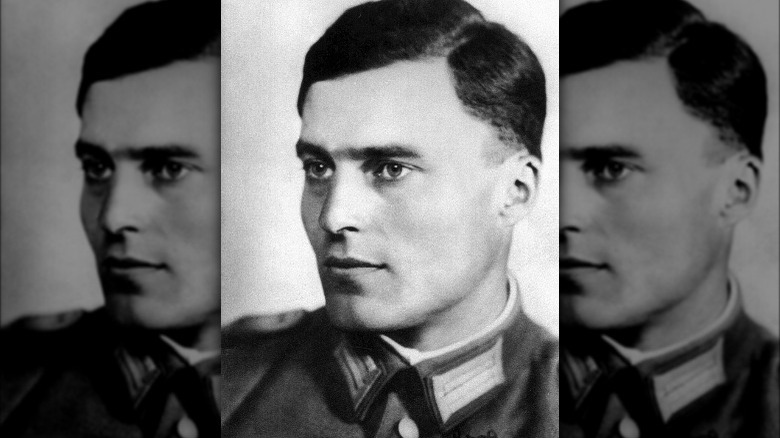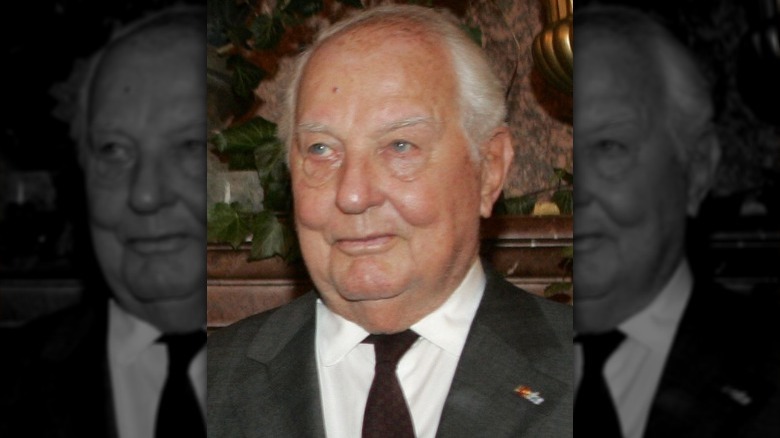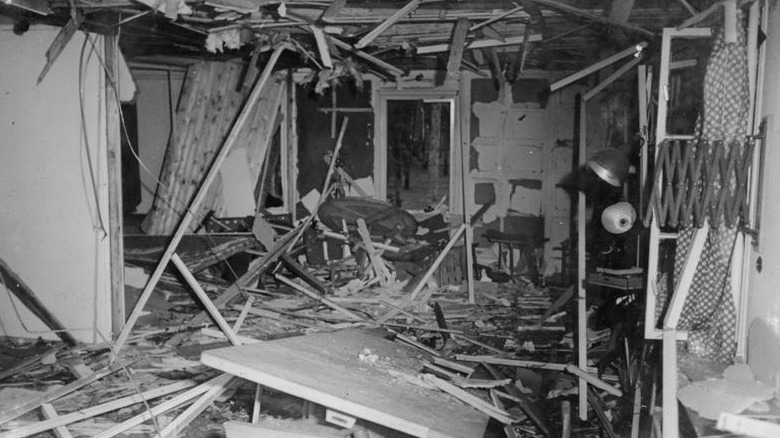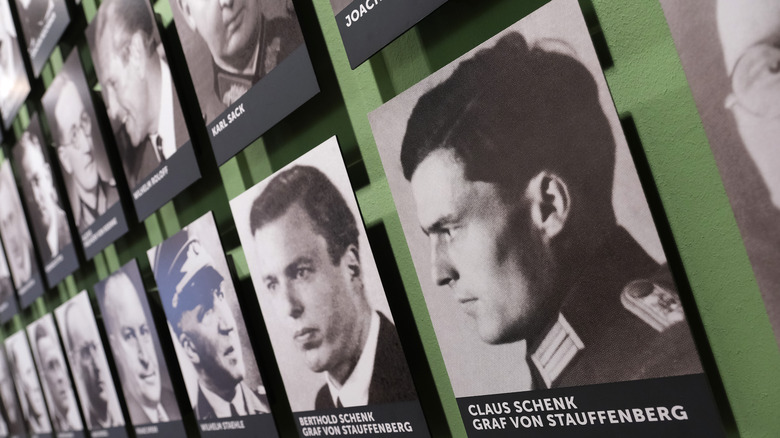The True Story Behind Valkyrie
If anyone had gone back to the 1980s and told die-hard fans of "Top Gun" and "Cocktail" that Tom Cruise was eventually going to be playing a Nazi, millions of teenage fans just wouldn't have been able to cope. It's true, though, but the 2008 movie "Valkyrie" wasn't about just any Nazi — it was about the Nazi that tried to kill Adolf Hitler with a bomb.
There's always a bit of difficulty in translating a complicated historical incident to the big screen, that's just the nature of the beast. Some things might be lost along the way, dramatized to keep audiences interested, or just left out altogether. How did "Valkyrie" do in telling the real story?
That's complicated, because there are some things that are still being debated by historians. And given the fate of the people involved in the plot, it's likely to remain that way. What we do know is a fascinating look inside the inner workings of Nazi Germany. Not everyone was, after all, thrilled with the idea of having Hitler in charge. And some were willing to pay the ultimate sacrifice if it meant freeing their beloved Germany from beneath the boot heel of the Third Reich and the Fuhrer.
There was more to the plan than just assassination
Colonel Claus von Stauffenberg may have been the face of Operation Valkyrie, but it was much bigger than just one person. According to the United States Holocaust Memorial Museum, the plan involved dozens of military and civilian conspirators — because it wasn't just about killing Hitler, it was about everything that would come afterward.
The actual assassination was pretty straightforward. At the time, Stauffenberg (pictured, far left) was an army officer who had already proven he was willing to do whatever he needed to for the Fatherland: According to the BBC, he had lost an eye, had his right hand amputated, and lost two fingers from his other hand as a result of active duty in Tunisia. As an officer, he was invited to daily briefings at Hitler's Wolfsschanze (pictured, background), and on July 20, 1944, he was going to walk in with a briefcase. That briefcase would have two bombs in it, and after putting it under the table, it would detonate and kill the Fuhrer.
Hitler's death would set off a chain reaction. Those involved in the plan would circulate information that members of the Nazi Party had attempted a coup, giving Germany's Reserve Army time to mobilize, arrest pro-Hitler party members, and seize various locations across Berlin. Scores of conspirators were standing by for the notice that it was go-time: There were high-ranking officers on standby in France, and in Germany, a new chancellor and president were lined up.
The bomb went off, but Hitler survived
What happened next is a weird series of events that is precisely the sort of thing that makes even the staunchest skeptic wonder if someone had gone back in time to muck about with the outcome of the assassination plot. Things started to go not according to plan when exceptionally hot weather necessitated a change in the meeting location. Then, when Claus von Stauffenberg ducked out to the bathroom to arm the bomb, harassment from a guard meant that he didn't have the time he needed to arm the second one.
Finally, the smallest of things ended up saving Hitler's life. Stauffenberg put his briefcase down right next to the Fuhrer, but when he left the room to take a conveniently-timed phone call — that was all part of the plan — another officer named Heinz Brandt moved the briefcase behind the solid oak leg of the table. The bomb killed four, but that table leg spared Hitler. Researchers from the University of Cambridge say that his clothes were shredded and he damaged an eardrum, but that was the extent of his injuries.
Thinking that the plan had been successful, Stauffenberg headed back to Berlin for the kick-off of the rest of the plan. When it was announced that Hitler had survived — and when he took to the radio waves himself later that night — the entire thing crumbled around the conspirators.
Claus von Stauffenberg didn't do all the planning
While it's Claus von Stauffenberg who's most closely associated with the 1944 plan to assassinate Hitler, he wasn't the one to come up with it. According to the Deutsches Historisches Museum, the whole thing really started in earnest with one man: Friedrich Olbricht (right). Olbricht had been anti-Nazi from the start, but — like many who opposed Hitler — he couldn't exactly come out and say so. Still, when he was installed as the head of the General Army Office (AHA) of the Reserve Army Command, it was a huge deal for the opposition. With someone sympathetic to the anti-Nazi cause at the end of a whole section of the army, that section would be likely to turn on a dime.
Olbricht was appointed in 1940, and quietly started working on a plan that he code-named Valkyrie. Even as more and more German soldiers died in the field, Olbricht started drawing up plans for things like sending the army into Berlin to quell unrest. Only, that wasn't exactly all the plans were.
Then, in 1943, another officer named Henning von Tresckow (left) started working with Olbricht to turn those plans into something that would form the basis of their coup. It wasn't until the fall of that year that Stauffenberg got involved — and when he did, his disillusionment with the way things were going in the war created an anti-Hitler mentality that made him one of the major players of Valkyrie.
The motivations were varied
Being involved in a plot to kill Adolf Hitler was akin to signing your own death warrant, but according to History, there were around 200 people who were willing to do just that. It's nice to think that these people knew what was going on in the concentration camps and were willing to die to put an end to it, but humans aren't that simple — or, it turns out, that selfless.
The good news is that some were, like Henning von Tresckow. Played by Kenneth Branagh in 2008's "Valkyrie," Tresckow had been an opponent of the Nazi regime way back into the mid-1930s ... albeit, quietly. Then, once he learned what was really going on at the concentration camps, all bets were off. McGill University history professor Peter Hoffman sums up Tresckow's position like this: "It was a question of personal honor and the need to prove to the world that there were Germans who had tried for years to bring the killing and destruction to an end."
The United States Holocaust Memorial Museum points out, though, that in many cases, it's just not known why conspirators signed on. Historians do know that many were more concerned about Germany than the world's Jews. Hitler needed to be stopped not because he was slaughtering huge sections of the population, but because he was completely incapable of leading Germany to victory over the Allies. It was concern for the future of Germany, not the Jews, that made many conspirators join up.
Some of the conspirators were horrible people
It's tough to imagine just what it was like living in Nazi Germany. No one was safe, so it's possible to understand how some may have been forced to do things that they never would have voluntarily done, had the circumstances been different. That said, not everyone who was active in the plot to kill Hitler was the sort that might get invited around to dinner after the war. According to History, there were quite a few conspirators who were downright awful people.
Take Arthur Nebe (pictured). According to the Jewish Virtual Library, Nebe was starting to doubt the wisdom of the Reich by the time aggression toward the Jews kicked off with the Night of the Long Knives. That was in 1934, and although he originally vowed to quit his position at the police department, he ended up playing both sides — even as he headed up one of the Nazi's mobile killing units, developed ways to make them much more efficient, and oversaw the murder of 45,000 people. Although he played a part in organizing Valkyrie, he turned on his co-collaborators when things went sideways, then vanished. (He was ultimately captured and hanged in 1945.)
Even the man who organized Stauffenberg's escape plane was a shady guy: Eduard Wagner was behind the organization of the ghettos, and was a huge proponent of the siege of Leningrad. By the time that came to an end, 600,000 civilians were dead.
Valkyrie was a backup plan
July 20, 1944 was kind of a last-ditch effort. By that time, Hitler had already survived dozens of assassination attempts, and History says that several of them had also been orchestrated by Henning von Tresckow. The first time Tresckow planned to cut the head off the snake, as it were, was in the summer of 1941. That was going to be a simple arrest, but Hitler was surrounded by members of the SS.
By 1943, he'd settled on the use of the bomb — and Operation Flash was supposed to go off on March 13. The bomb was going to be disguised as a gift of liquor, and it was outfitted with a delay switch designed to explode while Hitler's plane was in midair. The bomb was defective, though, and Tresckow pressed ahead with another plan with long-time collaborator Colonel Freiherr von Gersdorff (pictured) as a suicide bomber. Gersdorff was supposed to detonate a pair of bombs hidden in his coat as he accompanied Hitler on a museum tour, but when the Fuhrer swept through in just 8 minutes, it wasn't enough time for the 10-minute fuses to detonate. Again, Hitler walked away.
By the fall of that year, Tresckow had a new weapon: Claus von Stauffenberg had joined the fray, says Deutsches Historisches Museum, and — as the chief of staff for collaborator Friedrich Olbricht — he was already laying the groundwork for what would become the most famous attempt on Hitler's life.
Why did the following coup fail?
Henning von Tresckow and Claus von Stauffenberg were incredibly well-prepared and had laid out an intense framework of exactly how they wanted their post-Hitler military coup to go.
According to Deutsches Historisches Museum, Stauffenberg and his brother, Berthold, had created detailed instructions for the formation of task forces that would be issued specific orders after Hitler's death. And it would have been legit: With the Fuhrer dead, the powers to give those sorts of orders would have transferred to the Wehrmacht, where Valkyrie collaborators were ready and waiting for the word that it was go-time. Even front-line military actions would have been halted, under the command of new Wehrmacht commander — and Valkyrie conspirator — Erwin von Witzleben (pictured, center).
With so many chess pieces in place, what happened? When Stauffenberg got to Berlin, he and other major players tried to keep the momentum — and the coup — going in the face of reports that Hitler had survived the attempt. He — along with Friedrich Olbricht and a handful of other collaborators — was arrested within two hours. Had Hitler actually died, the movement would have been reinforced by everyone from soldiers who didn't feel comfortable breaking the oath they had sworn to him to high-ranking Nazis who perhaps weren't thrilled with the Third Reich, but felt duty-bound to fall in line.
What happened to the participants?
After the Valkyrie conspirators turned from would-be liberators to hunted men, it perhaps predictably went very, very badly for them. The conspirators had offices in a Berlin complex called the Bendlerblock, and it was there that Claus von Stauffenberg (left), Friedrich Olbricht, Albrecht Mertz von Quirnheim (right), and Werner von Haeften surrendered, and were then executed by a firing squad set up in the building's courtyard. According to Cambridge University, von Haeften made one last gesture of defiance, stepping in front of Stauffenberg to take the bullets meant for the would-be assassin. The execution was overseen by army commander Friedrich Fromm, who had known about the plot but refused to be a part of it. His attempt at clearing his own name in Hitler's eyes didn't work, and he was arrested and executed in March of 1945 (via the Jewish Virtual Library).
Stauffenberg's brother, Berthold, was executed in Plotzensee prison a few months later, strangled alongside seven others. Their deaths were filmed for Hitler to re-watch. It was the last attempt on Hitler's life that Henning von Tresckow was behind. When Valkyrie failed, he took his leave, started driving, and when he got to the Eastern Front, he completed suicide via hand grenade.
Arrests and executions continued in the following weeks, when DW says that 140 people directly associated with Valkyrie were arrested and executed. Stauffenberg and the rest of the conspirators were branded traitors, and remained traitors in the court of public opinion for years afterward.
The families of the executed paid a steep price
Claus von Stauffenberg's wife, Nina, was pregnant with their fifth child when he (pictured) was executed. His son, Berthold, was 10 years old, and in 2014, he told the BBC that he "was just about to become a little Nazi, like all of us." That changed after Valkyrie: "It was actually the next day that my mother took me and my brother aside and told me that it was our father who'd laid the bomb ... And she said, 'He believed he had to do this for Germany.'" Nina Stauffenberg was arrested that night, spent the remainder of the war in the Ravensbruck concentration camp, and although she survived, she never remarried.
With the collaborators considered traitors, Newsweek says that not only were the families of these ex-military men denied government support, but one-time friends, family, neighbors, and potential employers all avoided the women dubbed "traitor widows."
Axel Smed was a 4-month-old baby when his father, Gunther, was killed at Plotzensee prison. Hanged from a meathook and left to die there for trying to recruit the wrong person into Valkyrie, he left behind a family who only knew he was dead when they received a bill for the execution. He didn't know what happened to his father until he was nine, but before then, he had memories of teachers explaining away troubles he had in school: "Well, then, it's no surprise that he's bad at maths. He's the son of a traitor."
The last survivor
Not everyone who participated in the plot was captured and executed: In 2013, The Guardian ran the obituary of Ewald-Heinrich von Kleist. The 90-year-old Kleist had been the last survivor, and he'd been just 18 years old when he'd joined the army in 1940 — only to be recruited into the plot by Claus von Stauffenberg.
Both Kleist and his father were adamant anti-Nazis and were willing to do whatever it took to see the Third Reich fall. The original plan was that he was going to become a suicide bomber: When his unit paraded before Hitler, he was going to wear enough explosives to put the entire thing to an end. The parade was canceled before that could happen, and the Kleists became a part of the July 20 plot. Even as Stauffenberg placed the bomb, Kleist waited in Berlin for the order to engage whatever SS decided to remain loyal to Hitler, and help secure the city for the resistance.
His father was one of many who were arrested, put on trial, and executed in the aftermath of Operation Valkyrie, and while he, too, was arrested, he was interrogated and sent to a concentration camp. Inexplicably released, he was sent to the Eastern Front, survived the war, and went on to form the Munich Security Conference.
It may have been a good thing it failed
Here's the really weird thing: According to DW, more people died in the time between Claus von Stauffenberg's assassination attempt and the end of the war than in all the time leading up to that moment. It's easy to think that if he succeeded, everything would have turned out better, but historian Roger Moorhouse argues (via HistoryExtra) otherwise. Moorhouse says that Hitler's death would have set him up as a martyr, and "far from being undermined, Nazi rule would be strengthened."
He goes on to say that the collaborators would have had massive obstacles in their way, from fighting a widespread belief in a secret cabal determined to bring down Germany — the same cabal that Hitler did a lot of shouting about — to negotiating peace with the Allies, and dealing with the inevitable march of Stalin's Red Army.
Moorhouse also goes on to say that history is much more complicated than it would need to be to see one assassination bring the entirety of the Second World War to a grinding halt, and even goes as far as suggesting that whatever rose out of the ashes of the Third Reich may have been just as bad. In a nutshell: "The uncomfortable truth is that for Nazism's spell over the German people to be broken, it had to run its bloody course; it had to be seen to fail — utterly, completely, and catastrophically. For all its heroism, Stauffenberg's plot risked preventing that."
Lasting legacy
The fact that history remembers Operation Valkyrie at all is largely thanks to one of the collaborators. Fabian von Schlabrendorff was a lawyer, and survived the purge that claimed most of their lives in a weird twist of fate. In court about to be sentenced, the judge was killed by an American bomb. Schlabrendorff was instead sent to the concentration camp circuit, and survived to see liberation. Then, he turned his attention to helping the families of the executed get the support they so desperately needed. According to what his son told Newsweek, it was an unforgiving task: "He received death threats until his death [in 1980]. Germany lost the war, but Nazism still permeated the country."
Schlabrendorff later wrote "Officers Against Hitler," a book that detailed the collaboration that was Operation Valkyrie. Still, it wasn't until the 1960s that DW says public opinion started to view Stauffenberg and his compatriots as something other than traitors. Today, he's remembered in memorials, statues, and exhibitions — and in 2002, Germany's military recruits began taking their oaths on July 20.
Still, it's perhaps Sophie Bechtolsheim — Stauffenberg's granddaughter — who summed it up best, saying: "Otherwise, how would we be able to look the victims of the Nazi regime in the eyes? We can learn that taking a stand and taking the resulting action is not just necessary, but possible."
